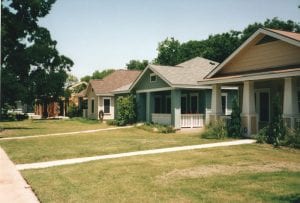
Affordable homes built by Guadalupe Neighborhood Development Corporation. Photo credit: Guadalupe Neighborhood Development Corporation.
Austin, Texas’ Guadalupe neighborhood—anchored by Our Lady of Guadalupe Church—is just east of the city’s Central Business District across Interstate Highway 35. The neighborhood is small, comprising approximately 14 blocks, and includes the historical site of one of the city’s first freedmen’s settlements, communities of formerly enslaved African Americans that emerged after emancipation.
Over the 20th century, racially discriminatory policies and practices contributed to an increased concentration of African American and Mexican American residents in Guadalupe. By 1970, 80 percent of the neighborhood’s residents were Mexican American, and 15 percent were African American.
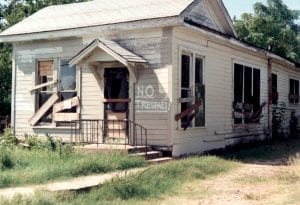
Photo credit: Guadalupe Neighborhood Development Corporation.
The 1980s saw heavy declines in the numbers of families with children and owner-occupied housing, and it became the poorest census tract in the city with more than half of its homes in substandard condition.
A Community-led Battle
In 1979, Austin leaders announced urban renewal plans to expand the French Legation museum in the Guadalupe neighborhood, which would have displaced at least 11 families. Neighborhood residents quickly banded together with church leaders, social justice advocates, and legal aid attorneys and successfully defeated the expansion project.
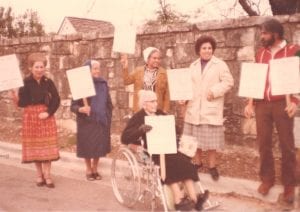
Guadelupe neighborhood residents protest urban renewal project, 1979. Photo credit: Guadalupe Neighborhood Development Corporation.
Blocking the expansion was a huge political victory for the neighborhood and strengthened the political and social capital of the neighborhood’s leaders. They subsequently secured approval from the Austin City Council to redirect $622,000 in funding from the French Legation project to a new community-generated development plan—the Guadalupe Community Development Project (GCDP).
The GCDP plan was developed by the newly formed Guadalupe Neighborhood Area Association based on resident surveys, feedback from community meetings, and door-to-door assessments of property conditions. The plan’s primary focus was to improve housing conditions and prevent the displacement of lower-income residents. Its strategies included downzoning of residential lots, offering counseling and deferred loans to help homeowners with repairs, improving the quality of rental housing, buying up vacant land, and repairing and improving streets, sidewalks, and alleyways.
Key to the plan’s implementation was the formation of a new community development corporation governed by community residents—the Guadalupe Neighborhood Development Corporation. GNDC’s initial board included church members who had been active in the French Legation battle. Allied organizations and social justice advocates also provided critical support.
GNDC moved quickly to implement the first phase of the GDCP plan. Within six months of receiving funding, GNDC met its home-repair goals and negotiated the purchase and financing of 10 homes to be rehabbed and sold to the existing tenants. Through GNDC’s “four corners strategy”—which involved acquiring strategically located lots across the neighborhood to impede land assembly for large redevelopment projects—GNDC acquired 14 rental units on 9 lots scattered throughout the neighborhood. This strategy gave GNDC additional clout in city zoning decisions. By 1989, the average lot price in Guadalupe was around $5,000.
1990-2000: Preserving Affordable Single-family Housing
Up to the 1990s, property values in Guadalupe remained largely stable and affordable. In 1990, the median value of an owner-occupied home in Guadalupe was $33,600, well below the city median value of $72,100. By the late 1990s, the neighborhood had experienced noticeable real estate growth, with median home values increasing to $51,100 by 2000 (again well below the city average of $120,800). During this period, however, displacement pressures were still minimal and vacant lots in Guadalupe could be purchased for between $10,000 to $40,000.
GNDC did not anticipate the dramatic rise in housing prices that was to come, and so throughout the 1990s, it continued with its single-family development focus and sold homes to low-income families without long-term affordability protections.
Throughout that decade, neighborhood efforts were also focusing on another development battle: a California-based real estate company had previously purchased and razed all but one of the homes on an 8-acre tract on the edge of the neighborhood known as the Bennett tract. In 1991, the Austin City Council rezoned the tract to allow for a 1.2 million-square-foot commercial development that would include a luxury hotel, office space, and a shopping mall, with heights of up to 22 stories. While the mall plans never materialized, the first phase of luxury apartments were eventually built in 2005 and the final phase was recently completed—condominium units starting at $325,000. The final size of the redevelopment project was limited by one holdout land owner—the family of a longtime GNDC board member.
Keeping Up With the Pace of Change
Since 2000, the Guadalupe neighborhood has undergone dramatic changes, with a large influx of higher-income, white newcomers. In 2000, Guadalupe’s census tract was 5 percent white with a median family income of $39,000. By 2016, the census tract was 43 percent white with a median family income of $67,000.
Guadalupe’s housing market has taken off. Single-family lots now sell for as much as $650,000. As a result, GNDC is no longer able to afford the cost of lots or homes in the neighborhood, and the neighborhood lost several affordable homes to the market that GNDC had previously sold to low-income families. While GNDC had a right of first refusal on these homes, there were no restrictions on the resale price. For example, a GNDC home sold to a low-income buyer in 2005 for $110,000 was resold by the buyers several years later for $213,000. Another home resold for $900,000. Of the 40 affordable homes GNDC sold between 1983 and 2008, at least eight have been resold to market-rate buyers.
The dramatic pace of change in Guadalupe and surrounding neighborhoods spurred GNDC to shift strategies and pioneer two new approaches: adding units to lots already owned by GNDC and creating permanently affordable homeownership opportunities through a community land trust.
In 2008, GNDC replaced two of its older duplexes with a 22-unit affordable apartment complex called La Vista de Guadalupe, which was funded with federal Low Income Housing Tax Credits and city dollars. GNDC is currently developing a 24-unit apartment complex on the one holdout lot in the Bennett tract. GNDC’s rents average $550 a month, while citywide, 1-bedroom apartments rent for $1,255 on average. GNDC’s waitlist for its properties exceeds 720 households. Through GNDC’s preference policy, low-income residents with historic ties to the neighborhood receive priority on the wait list.
GNDC has also added units to its single-family lots by building accessory dwelling units (ADUs), smaller homes that can be separate from or attached to a primary home and have their own entrance. After confronting the city’s restrictive development regulations that impeded the construction of ADUs, GNDC helped pave the way for reform. In 2001, the city council loosened restrictions on ADUs for neighborhoods that opted into the ordinance (including Guadalupe). Four years later, the city council further reduced restrictions and extended the ADU ordinance citywide. Since 2001, GNDC has built seven ADUs in the area, with rents between $300 and $900.
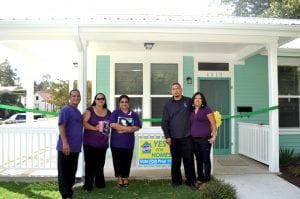
Ribbon cutting for GNDC community land trust home. Photo credit: Guadalupe Neighborhood Development Corporation.
In 2012, GNDC created the first community land trust (CLT) in Texas. Through the land trust, GNDC owns the land that the home sits on, which is leased to a low-income family for 99 years at $25 per month. The family owns the home, which is purchased at an affordable price via a bank mortgage. (A major roadblock in launching the community land trust was overcome when GNDC found a California-based mortgage lender willing to finance GNDC’s first CLT home.) When the CLT homeowner sells the home, GNDC has right of first refusal to purchase the home at a capped resale price. The resale price allows the family to recoup what it paid for the home and receive appreciation of 2 percent per year. This shared equity formula allows GNDC to resell the home to another low-income family at an affordable price. [Editors note: read more of Shelterforce‘s extensive coverage of community land trusts]
To ensure that land trust homes remain affordable in Austin—which has the eighth-highest property tax burden in the country—GNDC helped draft a 2011 state law that reduces the property taxes for CLT properties. GNDC also worked closely with the local appraisal district to develop a CLT-friendly appraisal methodology for CLT homes and land. Together, these policies result in thousands of dollars in annual tax savings for CLT homeowners.
Lessons for Other Communities
The community of Guadalupe’s 40-year struggle to fight displacement in the face of redevelopment pressures and swiftly rising land values is instructive for other communities facing similar challenges. Much of the neighborhood’s collective success in tackling displacement can be attributed to long-standing community involvement, a strong CDC, and early strategic land acquisition. Also important has been the CDC’s adoption of new strategies in response to changing conditions and lessons learned from prior work, such as creation of the state’s first community land trust and the development of accessory dwelling units.
Because of this work, the small neighborhood is home to 91 affordable units under long-term community control (including units under development)—more than half of the 168 homes that existed when the neighborhood first began its anti-displacement work four decades ago.
For more information: Uprooted: Residential displacement in Austin’s gentrifying neighborhoods and what can be done about it. UT Austin, 2018.

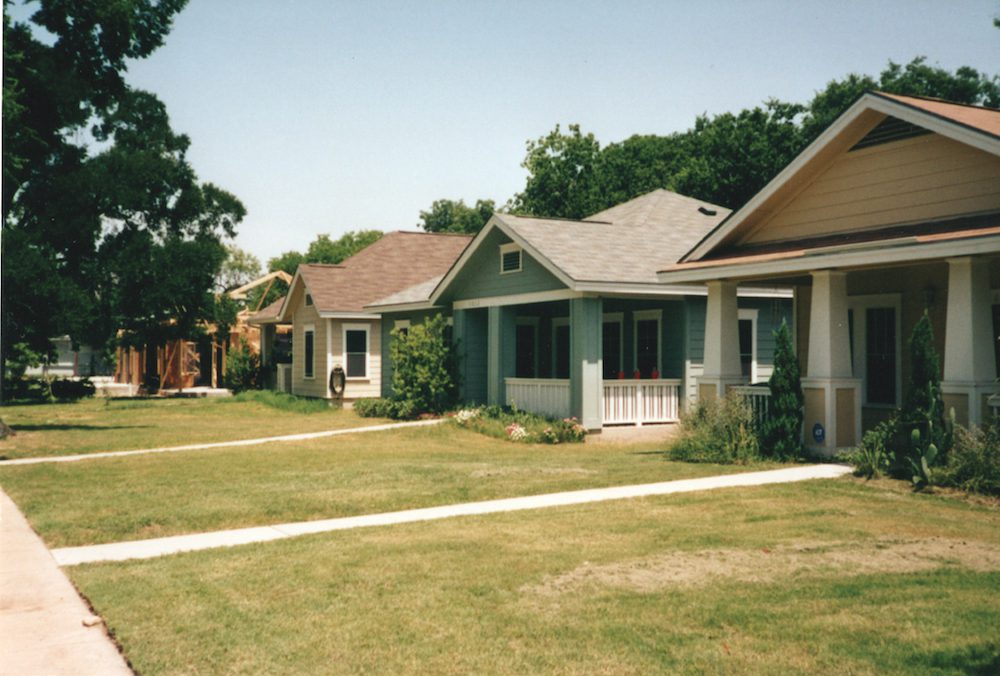



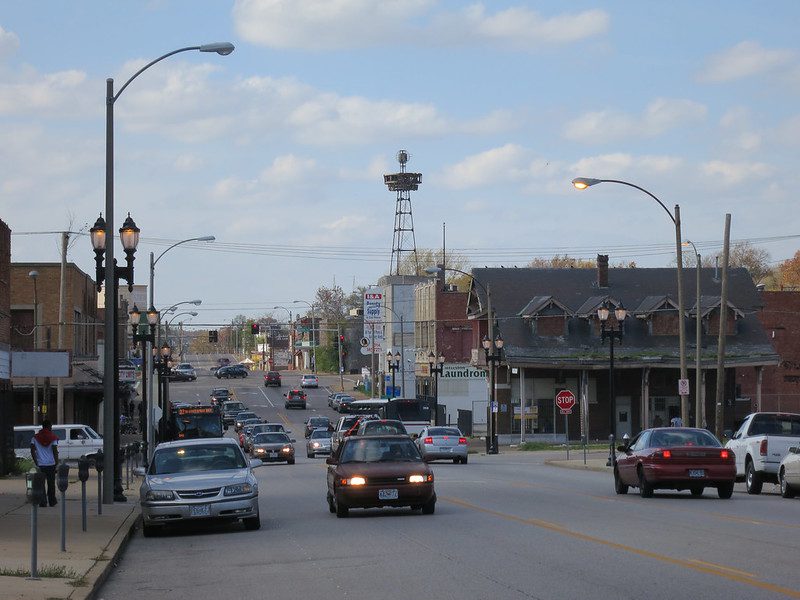
The information I learned about in this article has really touched my hart and made me become more passionate abuot the communitys fight against the housing crisis it faces. I want to become more involved and what service or VOICE I can provide to help please consider me part or your team . SINCERLY
Christopher R Armonta